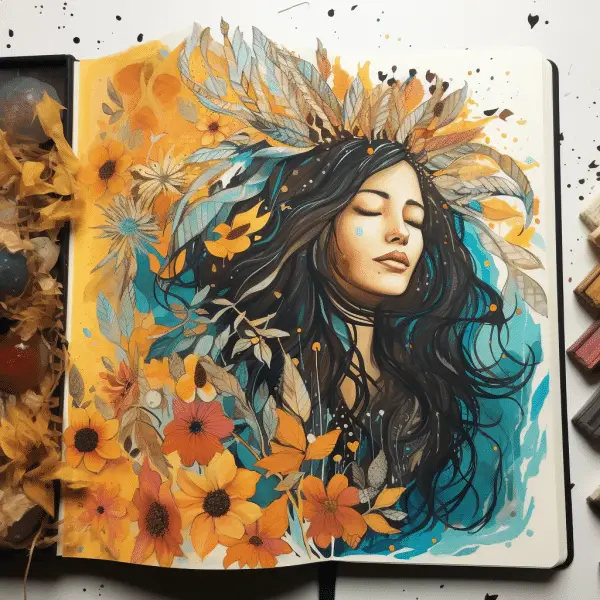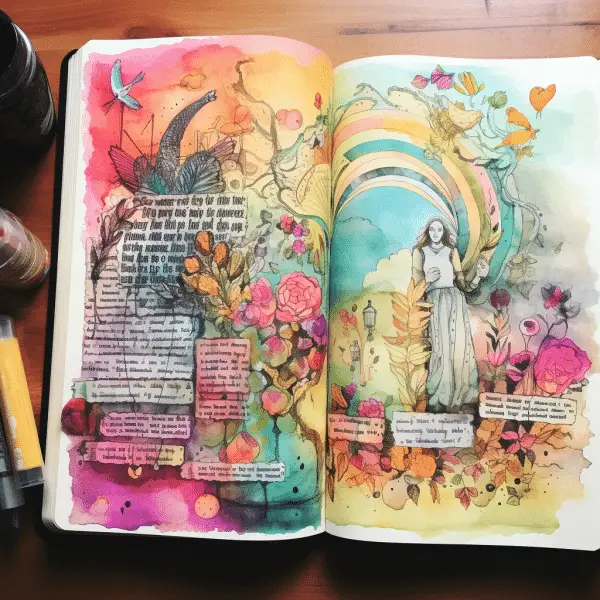
Exploring the Differences and Benefits of Bible and Art Journaling

Art journaling and Bible journaling have different purposes. Art journaling is about expressing yourself and using various art techniques to create visual diaries. Bible journaling focuses on biblical themes or verses. It’s an opportunity for people to meditate on scriptures and visually interpret their spiritual insights.
Art journaling enables people to reflect their emotions, thoughts and experiences. One can use paints, markers, collage materials or other mediums. It allows for freedom of expression. It can also involve other forms of artistic expression, such as calligraphy, hand lettering, coloring, and even incorporating printed images or photographs. Bible journaling centers around incorporating art and creativity into the study and reflection of Scripture, while art journaling allows for a broader range of personal expression without a specific religious context.
Bible journaling has a spiritual dimension. It’s a way for people to capture scriptural teachings. It can be done by adding illustrations directly onto the pages of their Bibles or in a dedicated journal.
Jane discovered Bible journaling during a difficult period in her life. She added watercolor paintings next to her favorite verses from Psalms. It helped her understand the scriptures better and gave her inner peace.
In conclusion, art journaling and Bible journaling offer therapeutic outlets for self-discovery and growth. They both express individual creativity, but the latter has a spiritual aspect.
Definition of Bible journaling
Bible journaling is a unique way to dig into the Bible. It combines writing, illustrations, and art. Different mediums like paints, pencils, stickers, and washi tape are used. It allows people to gain a better understanding of the bible while deepening their connection with God. Unlike traditional journaling or reading the Bible, Bible journaling involves creating visual designs which bring the words to life.
Bible journaling is different from other forms of visual expression. It focuses on religious themes and references from the bible. It often incorporates calligraphy or hand lettering to accentuate key verses. The goal of Bible journaling is to evoke emotion, inspire prayerful contemplation, or serve as reminders.
It’s important to find the right style when starting Bible journaling. Explore different art techniques such as watercolor painting or collage-making. Experimentation will help you discover what resonates best with your spiritual exploration.
Explanation of art journaling
Art journaling is a creative practice that fuses journaling and art. It uses mediums such as paints, markers, and collage materials to express oneself and document emotions and experiences. It’s all about self-expression with no hard rules or set guidelines.
It’s unique in that it embraces mistakes and imperfections. Traditional forms of art usually seek perfection, whereas art journaling encourages the journey more than the end result.
To make the most of it, here are some tips:
- Start with a blank page and let imagination lead the way.
- Experiment with techniques like collaging, stamping, and stenciling.
- Incorporate meaningful symbols to add depth and meaning.
- Use art to document emotions and experiences.
- Let go of expectations and enjoy the journey.
These suggestions help to tap into creativity and explore different artistic techniques. They also encourage emotional well-being through self-expression. Lastly, they remind artists to appreciate the journey and let go of expectations.
Similarities between Bible journaling and art journaling
Bible journaling and art journaling? They’ve got a lot in common! Creative expression? Check! Visual elements like colors, illustrations, and patterns? You bet! Writing and drawing prompts to encourage introspection? Absolutely! Plus, they both provide catharsis and make great outlets for self-expression.
Individuals can explore their own ideas and interpretations with words and imagery. It’s a great way to uncover personal stories, express emotions, and learn more about yourself.
But Bible journaling has something special – a spiritual dimension! It incorporates scripture texts, prayerful reflections, and faith-based themes into the creative process. This combination of artistry and spirituality allows you to connect with your faith in a unique, visual way.
So don’t miss out! Embrace this creative practice and discover new insights, deepen your connection with your spirituality, and unleash your artistic potential. Start your own journey of self-expression today!
Differences between Bible journaling and art journaling
Bible journaling and art journaling may look similar, but there are differences. Let’s discover them!
Differences between Bible journaling and art journaling:
| Bible Journaling | Art Journaling | |
|---|---|---|
| Purpose | Connect with God | Express thoughts & emotions |
| Focus | Biblical passages | Different themes & ideas |
| Materials | Religious symbols & imagery | Variety of materials & techniques |
| Guidelines | Specific interpretations of scripture | No rules |
| Audience | Mainly religious individuals | Creative people |
Bible journaling
Focuses on connecting with God through reflection on scripture. It often includes religious symbols and follows interpretations of scripture. Art journaling has no set guidelines or rules, and is about exploring various themes and personal thoughts.
Both forms of journaling can be therapeutic. They offer self-expression, reflection, and creativity. No matter which form you choose, both have unique benefits. It can also involve other forms of artistic expression, such as calligraphy, hand lettering, coloring, and even incorporating printed images or photographs. Bible journaling centers around incorporating art and creativity into the study and reflection of Scripture, while art journaling allows for a broader range of personal expression without a specific religious context.
If you’re new, here are some tips:
- Examine which form suits you best.
- Gather materials like colored pens or pencils for Bible journaling, or paints, markers, and collage materials for art journaling.
- Find inspiration from religious texts, art books, or online platforms. Note techniques, themes, and styles that interest you, and use them in your practice.
By following these tips, you can begin Bible or art journaling. Enjoy the process, and express yourself and connect with God or your thoughts in a meaningful way. It can also involve other forms of artistic expression, such as calligraphy, hand lettering, coloring, and even incorporating printed images or photographs. Bible journaling centers around incorporating art and creativity into the study and reflection of Scripture, while art journaling allows for a broader range of personal expression without a specific religious context.
Benefits of Bible journaling
Bible journaling is a unique practice combining Bible study with artistic expression. It’s more than just note-taking; you can draw, paint, and even practice calligraphy on your pages! This type of journaling is a great opportunity for self-reflection and spiritual growth. Plus, it helps to improve memorization and encourages mindfulness while reading.
To get started, pick a passage that speaks to you. Then, select art materials that make you feel motivated and creative. Try out different lettering styles and mixed-media collages to add depth to your artwork. With these tips, you can dive deeper into the Word and cultivate a closer relationship with God. Let your creativity shine as you explore the Bible in your own meaningful way.
Benefits of art journaling
Art journaling has a wealth of benefits to amp up your creative process and personal growth. It lets you express yourself through visuals and tactile forms. Here are some of its advantages:
- Self-Reflection: It’s a secure space to reflect on your feelings and thoughts, which helps with self-awareness and progress.
- Stress Release: Artsy activities are known to cure stress through calming and meditative activities.
- Creative Outlet: Art journaling is the perfect way to access your creativity by using diverse materials, techniques, and styles.
- Confidence Boost: Creating something special can give you a confidence boost and strengthen your art skills.
- Memories: Art journaling is a special way to document and preserve memories from life.
- Accomplishment: Finishing an art project or page gives a feeling of accomplishment and encourages you to explore new ideas.
Plus, it offers you a chance to connect with artistic people, share thoughts, and get inspired. It’s a mindful practice that allows you to be in the moment without judgement.
As you start your art journaling journey, don’t be afraid of mistakes as it adds to the authenticity of your creations. Pro Tip: Have fun with different mediums such as watercolors, collage elements, and even found objects to bring out unique textures and dimensions in your art journal pages.
Conclusion
Bible journaling takes the text and brings it alive with illustrations and calligraphy. It’s a way to study scripture, reflecting and interpreting it through creativity. Art journaling is different, it’s all about expressing emotions, thoughts and experiences without rules.
The main focus of Bible journaling is connecting with God and having a deeper spiritual experience. It encourages people to meditate on scripture and make it part of their lives. Art journaling is more about self-expression and understanding oneself better.
During the Protestant Reformation, Martin Luther translated the Bible into vernacular languages. This let everyday people access and engage with it directly, leading to more interest in exploring its teachings creatively. This is still popular today as a way to connect with faith and express oneself artistically.
Bible journaling and art journaling both offer creative expression, but are very different. Bible journaling is for spiritual growth, while art journaling is for exploring yourself. Both practices can be beneficial for personal growth and artistic development. So go ahead, get creative and make something meaningful!
Frequently Asked Questions
FAQ 1:
What is Bible journaling?
Bible journaling is a form of artistic expression where individuals create artwork in their Bibles. It involves combining art, journaling, and personal reflection to visually engage with Scripture.
FAQ 2:
What is art journaling?
Art journaling is the practice of creating visual representations and expressing thoughts, emotions, and ideas through various art techniques. It is typically done in a personal journal or sketchbook.
FAQ 3:
What makes Bible journaling different from art journaling?
The main difference between Bible journaling and art journaling is the focus. Bible journaling centers around incorporating art and creativity into the study and reflection of Scripture, while art journaling allows for a broader range of personal expression without a specific religious context.
FAQ 4:
Can you use art journaling techniques in Bible journaling?
Yes, many art journaling techniques can be applied to Bible journaling. This includes using different art supplies, such as paints, pens, and collage materials, as well as various techniques like layering, stamping, and mixed media.
FAQ 5:
Is Bible journaling limited to drawing or painting?
No, Bible journaling is not limited to drawing or painting. It can also involve other forms of artistic expression, such as calligraphy, hand lettering, coloring, and even incorporating printed images or photographs. Bible journaling centers around incorporating art and creativity into the study and reflection of Scripture, while art journaling allows for a broader range of personal expression without a specific religious context.
FAQ 6:
Do I have to be an artist to engage in Bible journaling or art journaling?
No, artistic skills are not a prerequisite for Bible journaling or art journaling. Both practices are about personal expression and reflection, and there are no specific rules or expectations regarding artistic ability. It is a space for everyone to explore and enjoy.
